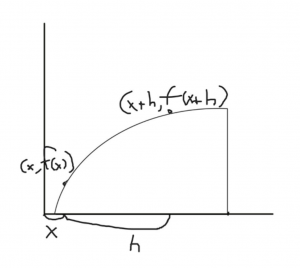When discussing creative writing, saying something is “derivative” implies that there wasn’t much thought put in, and the writer copied ideas from other works.
In math, derivative equations aren’t equations that suggest a lack of imagination but rather help find the average slope between two points. Derivative math problems can range from “hey, that’s not so hard” to “when did math become all letters and symbols?”
This article will discuss how to calculate derivatives and make the concept as clear as possible. While learning math can feel like learning a new language, once you understand what new symbols mean and how they operate, you’ll be able to get some more complex equations.
If you’re wondering how finding the derivative of a function is ever going to come in handy, well, let’s say you want to get into one of the following careers:
- Engineering
- Construction
- Architecture
- Visual Arts
- Seismology
- Medicine
- Computer Programming
Understanding derivatives calculus equations, particularly without the use of a calculator, will be incredibly helpful.
What Does Derivative Mean?
We’ll look at some derivative definition math examples shortly, but let’s give you a working definition for now.
The derivative shows the rate of change of functions with respect to variables.
In calculus and differential equations, derivatives are essential for finding solutions. Let’s look at a derivative math equation to better understand the concept and offer some definitions for the various symbols used.
The simplest way to look at a derivative equation is to relate it to a slope on a graph.
We can see that x runs along the bottom horizontally, and y runs along the left side vertically.
There’s a line running through the graph, and we’re going to find a number representing the overall change or average slope between two points on the line. We can write the equation this way:
Slope = Change in Y
Change in X
If the slope of the line were such that the change in x between the two points were 3, and the change in y was 6, we would get an equation that looks like this:
Slope = 6
3
Divide to arrive at:
Slope = 2
We now know the average slope of the line! Easy, right? Well, hold on, because what do we do if we need to find the average slope between two points on a curved line?
With curves, the formula for how to calculate derivatives gets a bit more complex. Plus, we’re going to add in our first derivative math symbol.
Slope = Change in Y = Δy
Change in X = Δx
The triangle symbol, Δ, is called “Delta.” We can think of it as meaning “change in.”
The formula would be the change in y divided by the change in x. Now we’ll get to another symbol we need to know.
Take a look at this equation:
Δy = f(x+Δx)
Δx Δx
See the f? The f in derivative math equations means the “function,” or how much the slope changes. F relates input to output so that we can understand the relationship between equation and answer. If we had a function:
f(x) = 2x
We would know that whatever number we put in for x would be multiplied by 2.
f(3) = 2(3)
Multiply, and we get:
f(3) = 6
Remember that when solving a derivative equation, the goal is to make Δx move towards zero.
You might think you’re looking at a bunch of code so far, but trust us, you’ll get used to it.
First, we’re going to take our function and apply it to our equation. Since f(x)=2x, we know that we want to use this to our advantage when solving this problem. We’ll start one piece at a time.
If f(x)=2x
Then f(x+Δx)=2(x+Δx) because essentially “f” means that we multiply whatever’s in the parentheses after f by 2.
Using the distributive property of algebra, we know that we can simplify to get 2x+2(Δx), which we’ll change to 2Δx+2x:
Δy = 2Δx+2x
Δx Δx
Because we’re working on getting Δx to be as close to zero as possible, what happens when we put 0 in for Δx? Well, we’re dividing by 0 at that point, and 2 times 0 is zero, so we’re left with this:
2x
0
This step brings us to zero! So we know that whatever figure we put in for Δx, we’ll know the average rate of change for our slope.
Isn’t There a Slope Formula In Algebra? What’s the Difference?
Yes, the slope formula in algebra is:
m=y2-y1
x2-x1
In algebra, m equals slope. But algebra is more concerned with solving equations, whereas derivatives calculus is about finding rates of change.
The method of finding the rate of change of the slope that we used earlier isn’t the only method, and there are other notations you need to be aware of. Let’s look at another equation and graph and break down what they mean. Take a look at this graph: 
Those points are our y values that we’re going to solve. To find our rate of change, we want to look at it this way:
lim f(h+x)-f(x)
h→0 x+h-x
Because we can get rid of the bottom x’s (x minus x is 0), we can rewrite it like this:
lim f(h+x)-f(x)
h→0 h
Some definitions to help! When we write “lim” and “h→0,” we’re writing the limit as h approaches zero. We want to find the limit of our slope, and we’re going to put it into our formula.
Because curved lines change along their length, we’re interested in finding the average rate of change, which is best expressed as a formula. You may see this entire formula referred to when being taught how to calculate derivatives as f’(x). So it would look like:
f’(x) = lim f(h+x)-f(x)
h→0 h
The way to say f’(x) is f prime of x. This expression is the derivative. Let’s solve an example and find the derivative of a function. Let’s say that:
f(x)=x²
Now we can put x² into our formula:
(x+h)²-x²
h
Which becomes, thanks to the distributive property:
x²+2hx+h²-x²
h
We can eliminate the two x²s:
2hx+h²
h
We can then use the distributive property to make this easier to read:
h(2x+h)
h
Because we can divide out the h, we then have:
2x+h
We’re always interested in finding the limit as it approaches zero, so let’s put in zero for h:
2x+0
We’re left with:
2x
Which means:
f’(x)=2x
Now, let’s say we want to find a specific slope to a particular set of points. Let’s say we want to find the line slope at x coordinate 3 and y coordinate 6.
f’(3)=2(3)
So:
f’(3)=6
At the coordinate points we picked, the slope is 6. Solved!
Parents, you might be learning this alongside your kids, so have patience with yourself as much as them!
Now, let’s say we wanted to find the solution for our tangent line. The tangent line just touches the curve, unlike a secant line, which touches the curve at two points.
We can find the average rate of change at any point on the slope by pretending we have a line going through it. Let’s punch some numbers from our derivative equation example. We’re going to use the point slope formula:
y-y1=m(x-x1)
We’ll use our earlier coordinates to solve this:
y-6=6(x-3)
We get:
y-6=6x-18
Which becomes:
y=6x+12
Remember, we’re not trying to get down to a number, but find a formula that works.
Why Do I Need to Know How to Calculate Derivatives?
Fair question. What is the practical application of being able to solve derivative math equations? Perhaps you’ll be surprised!
Calculate Projectile Trajectory
We know the effect of gravity. A falling object has a rate of acceleration of 9.08 meters per second per second. We can write the gravity formula as 9.8 m/s².
If we write our function as x(t) with t being time, we can calculate where a launched object will land or where it will be in the air at any given point. The full formula would look like: x′′(t)=−9.8 m/s² to show how an object drops using derivative math.
Calculate Heat Spread
Because we know a constant temperature source radiates heat through solids at a known rate, we can find out the exact temperature at any given distance from the heat source. This calculation is important in determining the strength of materials in certain situations, such as designing heat shields.
Calculate Economic Information
Calculus and derivative math knowledge are important in economic calculations. Derivative math can help calculate the cost of goods over time at specific prices and forecast the results. No matter what business you get into, the sooner you learn to calculate such essential figures using derivative math, the better.
Learning Derivatives Is Tough But Worthwhile
We’ve looked at some derivative definition math examples, but you may still be thinking, “I’m never going to use this; it’s not for me!” Remember that learning new skills like this exercises your brain and helps you with critical thinking skills. It’s not just learning an isolated ability.
You’ll learn how to calculate derivatives, and your brain will extrapolate that information and solve problems in other areas. It will! No matter what career you find yourself in, learning math is essential.
Musicians need derivative math to understand music with complex timings. Writers may need to learn derivative math if they’re creating stories with characters who understand math.
Engineers, construction workers, even craftspeople and companies creating firearms — and the people using those firearms — need to understand how to use derivative math to comprehend ballistics.
Ultimately, you may need to find a good tutor to grasp derivative math to the best of your ability. More strange symbols will show up the more you work at it! But these concepts aren’t impossible to understand. Once you learn one function or concept of derivative math, you’ll get a new one to add to your repertoire.
There’s always a new challenge in math, so if you’re the type of person who wants to exercise their gray matter, this is a fantastic area to do so. The old cliche is that your brain is a muscle. While that’s not strictly true, it does need exercise.
Why not exercise it with some math? All you need is a piece of paper or computer document and a calculator. Do you have a trick for understanding derivative math? We’d love to hear about it! Put it in the comments section below!
Phina Pipia
